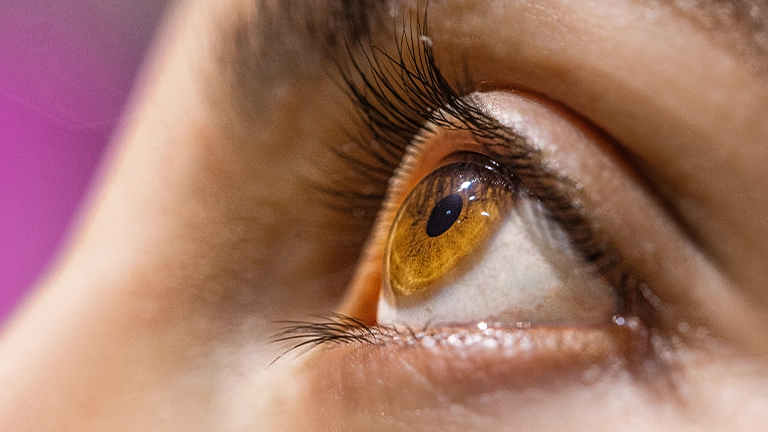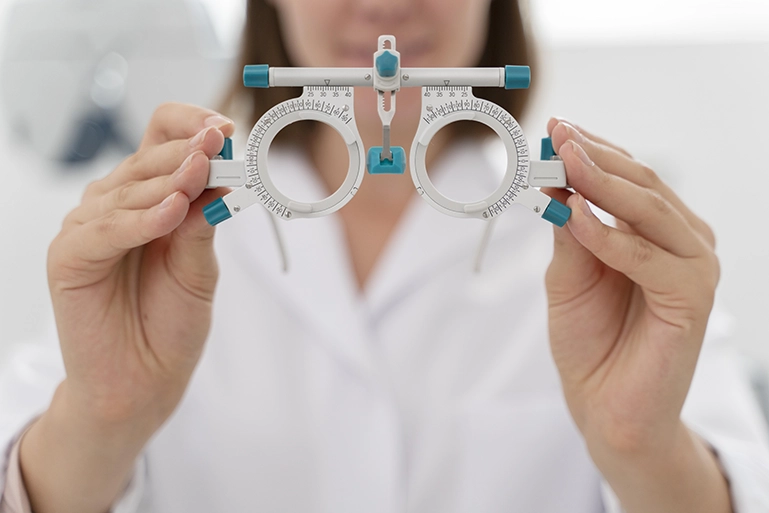Ever looked in the mirror and noticed the whites of your eyes have a yellow tint? It might seem subtle at first, but the yellowing of the eyes can be your body’s early warning sign, and it’s not something to ignore.
While it might be easy to blame fatigue or allergies, yellow eyes often point to deeper issues, including liver problems, bile duct blockage, or even certain blood disorders. In some cases, it’s the eyes, not your blood work, that offer the first visible clue something’s off.
In this post, we’ll break down the most common causes of yellow eyes, related symptoms to watch for, and why visiting an optometrist could be a crucial first step in getting an accurate diagnosis.
Contents
- 1 Yellow Eyes: Top Causes and Health Implications
- 2 Common Causes of Yellow Eyes
- 3 Recognizing Symptoms Accompanying Yellow Eyes
- 4 When to Consult an Optometrist
- 5 Diagnostic Procedures by Optometrists
- 6 Treatment Options for Yellow Eyes
- 7 Preventive Measures and Lifestyle Modifications
- 8 FAQs About Yellow Eyes
- 9 Final thoughts: Prioritize Your Eye Health
Yellow Eyes: Top Causes and Health Implications
If the white part of your eyes starts to look yellow, it’s usually a sign that something in your body isn’t working quite right. This yellow color is often caused by a substance called bilirubin, which your body makes when it breaks down old red blood cells. Normally, your liver helps get rid of bilirubin, but if the liver is sick or not working well, bilirubin can build up and turn your eyes yellow.
This can be a sign of problems like liver disease, a blocked bile duct, or other health issues. It’s your body’s way of waving a red flag and saying, “Hey, something’s wrong!” So if you or someone you know has yellow eyes, it’s important to tell a doctor or an eye specialist (optometrist) right away to find out what’s causing it.
The Role of Bilirubin in Eye Discoloration
Bilirubin is a yellow substance your body makes when it breaks down old red blood cells. Normally, the liver processes bilirubin and helps remove it from your body. But when the liver isn’t working properly, or there’s a blockage in the bile ducts, bilirubin can build up in your blood.
As this buildup increases, it can settle into different parts of your body, including the sclera (the white part of your eyes), causing them to look yellow. This yellowing is often one of the first visible signs of a condition called jaundice.
Differentiating Between Jaundice and Other Causes
While jaundice is the most common reason for yellow eyes, it’s not the only one. Other possible causes include certain medications, infections, genetic conditions, or even rare blood disorders that affect how your body handles red blood cells.
In some cases, yellowing may also result from poor diet, alcohol use, or damage to the pancreas or gallbladder. That’s why it’s important not to assume jaundice is always the cause, getting a proper diagnosis from a doctor or optometrist is key to understanding what’s really going on.
Common Causes of Yellow Eyes
Yellowing of the eyes is often a visible clue that something deeper is going on in the body. This discoloration usually signals an issue with bilirubin metabolism, which can result from a variety of health conditions.
Below are some of the most common medical reasons why the whites of your eyes might turn yellow, and why it’s important to seek professional care, possibly from the best optometrist in Toronto, who can help identify the underlying cause and refer you for further testing if needed.
Liver-Related Conditions
If yellow eyes are caused by liver-related conditions like hepatitis, cirrhosis, or liver cancer, treatment will focus on improving liver function and reducing high bilirubin levels in the body. Common liver-related causes include:
- Hepatitis (inflammation of the liver caused by viruses, alcohol, or toxins)
- Cirrhosis (scarring of liver tissue from long-term damage)
- Liver cancer, which can disrupt normal liver function and bilirubin processing
Conditions like fatty liver disease can also contribute to poor liver function and increased bilirubin, leading to the yellowing of your eyes over time.
Hemolytic Anemia and Blood Disorders
In hemolytic anemia, the body breaks down red blood cells faster than it can replace them. This leads to a surge in bilirubin levels, which the liver may struggle to clear.
As a result, excess bilirubin can cause the eyes to appear yellow. Other blood-related disorders can have a similar effect, especially those that affect the life span or health of red blood cells.
Bile Duct Obstruction
The bile ducts are small tubes that carry bile (which contains bilirubin) from the liver to the intestines. If these ducts become blocked, due to gallstones, tumors, or inflammation, bilirubin can’t flow properly and backs up into the bloodstream.
This often causes both jaundice and yellowing of the eyes, and may be accompanied by symptoms like dark urine, pale stools, or abdominal pain.
Genetic Disorders
Some people are born with inherited conditions that affect how their bodies process bilirubin. A common example is Gilbert’s syndrome, a mild liver disorder that can occasionally cause yellowing of the eyes, especially during times of stress, illness, or fasting. While it’s usually harmless, it’s still important to rule out more serious causes with the help of a healthcare professional.

Recognizing Symptoms Accompanying Yellow Eyes
Yellowing of the eyes is often one of the first visible signs of a deeper health issue, but it’s rarely the only symptom. Paying attention to other changes in your body can help you and your healthcare provider better understand what’s causing the discoloration. Here are some common symptoms that may appear alongside yellow eyes:
Skin Discoloration
When the whites of the eyes turn yellow, it’s common for the skin to develop a similar yellow tint. This condition is known as jaundice and typically indicates a buildup of bilirubin in the body. The yellowing usually starts in the eyes and then spreads to the skin, especially noticeable in areas like the face and chest.
Dark Urine and Pale Stools
Changes in the color of your urine and stools can also signal a problem with how your body is processing or eliminating bilirubin.
- Dark urine may appear tea or cola-colored due to excess bilirubin being excreted by the kidneys.
- Pale or clay-colored stools suggest that bilirubin isn’t reaching the intestines, possibly due to a bile duct blockage or liver dysfunction.
These signs are important clues and should prompt medical evaluation.
Fatigue and Abdominal Pain
When yellow eyes are accompanied by extreme tiredness, weakness, or discomfort in the upper right side of the abdomen, it may point to an underlying liver condition. The liver is responsible for filtering toxins and managing energy levels, so when it’s not functioning properly, the entire body can feel the effects.
When to Consult an Optometrist
While occasional or mild eye discoloration might seem harmless, persistent yellowing of the eyes can signal a serious underlying health issue that needs professional evaluation.
An optometrist is often one of the first healthcare providers to spot signs of systemic illness during a routine eye exam. Knowing when to seek help can lead to early diagnosis and more effective treatment.
Persistent Yellowing
If the yellow tint in your eyes lasts more than a few days, worsens over time, or appears without an obvious cause (like temporary illness), it’s important to schedule an eye exam. Long-term yellowing is often a sign that your body is not properly processing bilirubin and needs further evaluation.
Accompanying Visual Changes
If you experience blurry vision, light sensitivity, eye pain, or sudden vision changes along with yellowing, this could indicate more than just a bilirubin imbalance. These symptoms may suggest inflammation, infection, or pressure-related issues that require immediate attention from an eye care professional.
Systemic Symptoms
When yellow eyes are paired with other symptoms like fatigue, abdominal pain, nausea, dark urine, or skin discoloration, it’s a clear sign that something more complex is happening in your body. An optometrist can assess your eye health and refer you for appropriate medical tests or to a specialist if needed.
Diagnostic Procedures by Optometrists
Optometrists are trained to detect more than just vision problems—they can also identify signs of systemic health issues, including those that cause yellowing of the eyes. While they may not treat the underlying condition directly, optometrists play a crucial role in the early detection and referral process, helping patients get the appropriate care they need.
Comprehensive Eye Examination
When you visit an optometrist for yellow eyes, they’ll begin with a detailed eye examination, which typically includes:
- Visual acuity testing to assess the clarity of vision
- Slit-lamp examination to closely inspect the sclera (white of the eye), conjunctiva, and surrounding tissues
- Evaluation of eye pressure and internal structures to rule out inflammation or other ocular issues
- Review of medical history and current symptoms to understand potential systemic connections
This thorough approach helps the optometrist determine whether the yellowing is eye-related or a sign of a broader health problem.
Referral for Medical Testing
If the optometrist suspects that yellowing is linked to liver dysfunction, bile duct blockage, or another systemic issue, they will refer you to the appropriate healthcare provider, such as your family doctor, a hepatologist, or a gastroenterologist. They may recommend further diagnostic tests, including:
- Blood tests to check liver function and bilirubin levels
- Ultrasound or imaging scans to examine the liver, gallbladder, or bile ducts
- Specialist evaluations for potential blood disorders or genetic conditions
Treatment Options for Yellow Eyes
Treating yellow eyes starts with identifying the underlying cause. Since yellowing is usually a symptom of a deeper medical issue, such as liver dysfunction, blood disorders, or bile duct problems, effective treatment depends on properly diagnosing and managing that root condition.
For cases where yellowing of the eyes is related to ocular conditions or more complex health issues, seeking professional Eye Disease Treatment is essential. A personalized care plan, developed by a team of experts, can effectively manage symptoms and support long-term eye health. Below are the most common treatment approaches based on the source of the issue.
Addressing Liver Conditions
If yellow eyes are caused by liver-related conditions like hepatitis, cirrhosis, or liver cancer, treatment will focus on improving liver function and reducing the buildup of too much bilirubin in the body. This may include:
- Antiviral medications for viral hepatitis
- Lifestyle changes such as avoiding alcohol, improving diet, and managing weight
- Liver-supportive medications or supplements as recommended by a doctor
- In severe cases, liver transplantation may be necessary if there is irreversible liver damage
Managing Blood Disorders
For cases where yellow eyes result from hemolytic anemia or other blood-related conditions, treatment targets the rapid breakdown of red blood cells. Options may include:
- Medications to suppress the immune system in autoimmune-related hemolytic anemia
- Folic acid supplements to support red blood cell production
- Blood transfusions in more severe cases
- Treating any underlying infections or genetic causes that contribute to red blood cell destruction
Surgical Interventions
When yellowing of the eyes is due to a bile duct obstruction, such as from gallstones, tumors, or scarring, surgical intervention may be necessary to restore proper bile flow. Treatments might include:
- Endoscopic procedures like ERCP (Endoscopic Retrograde Cholangiopancreatography) to remove blockages
- Gallbladder removal surgery if gallstones are the root cause
- Surgical bypass or stent placement for tumors or chronic obstruction
Preventive Measures and Lifestyle Modifications
While yellow eyes are often a sign of an underlying medical issue, many of the conditions that cause them, particularly liver-related disorders, can be prevented or managed through healthy lifestyle choices. By taking proactive steps, you can protect your liver, support your overall health, and reduce the risk of developing the issues that lead to yellowing of the eyes.
Healthy Diet and Regular Exercise
A well-balanced diet and consistent physical activity are essential for maintaining liver health and proper blood function.
- Eat foods rich in fiber, lean proteins, healthy fats, and antioxidants
- Include leafy greens, whole grains, and cruciferous vegetables (like broccoli and cauliflower), which support liver detoxification
- Engage in moderate exercise for at least 30 minutes most days to promote circulation and reduce fat buildup in the liver
These habits not only support liver function but also help regulate metabolism and prevent obesity-related liver disease.
Avoiding Alcohol and Toxins
Alcohol is one of the most common contributors to liver damage. To reduce your risk:
- Limit or avoid alcohol consumption, especially if you have a history of liver issues
- Be cautious with over-the-counter medications like acetaminophen, which can strain the liver in high doses
- Avoid exposure to environmental toxins and use household chemicals and cleaners in well-ventilated areas
Minimizing exposure to liver irritants gives your body a better chance to process bilirubin efficiently.
Regular Medical Check-Ups
Routine health screenings are key to catching potential issues early, before symptoms like yellow eyes appear.
- Get regular blood tests to monitor liver function and red blood cell health
- Schedule annual physicals with your healthcare provider
- If you have a family history of liver or blood disorders, discuss it with your doctor for early risk assessment

FAQs About Yellow Eyes
When should I see a doctor about yellow eyes?
See a doctor if the yellowing lasts more than a few days, gets worse, or is accompanied by symptoms like fatigue, dark urine, or abdominal pain.
What is the test for yellow eyes?
Doctors usually order blood tests to check liver function and bilirubin levels. Imaging (like ultrasound) may be used to check for blockages or liver damage.
What disease has a symptom of yellow eyes?
Liver diseases such as hepatitis, cirrhosis, and bile duct obstruction are the most common. Blood disorders and certain infections can also cause yellow eyes.
What vitamins should I take for yellow eyes?
Vitamin B12, vitamin C, and folate may support liver and blood health, but always consult a doctor before starting supplements.
Can eye drops reduce yellow eyes?
No, eye drops don’t treat the cause of yellow eyes. The yellowing is usually due to internal health issues, not an eye surface problem.
Final thoughts: Prioritize Your Eye Health
Yellowing of the eyes is often the body’s first visible sign of underlying health problems, particularly liver conditions like hepatitis or cirrhosis, blood disorders such as hemolytic anemia, or bile duct obstructions. While the discoloration may seem minor at first, it can signal a serious issue that requires immediate medical attention.
A comprehensive eye exam with an optometrist not only helps rule out ocular causes but can also uncover systemic conditions early, when treatment is most effective. If you notice persistent yellowing, especially with symptoms like fatigue, dark urine, or abdominal pain, don’t delay. Prompt evaluation could lead to early diagnosis and significantly improve your long-term health outcomes.
Have questions about yellow eyes or personal experiences to share? Drop a comment below. We are here to help and learn from each other. Your insight could help someone else on their health journey, too!

